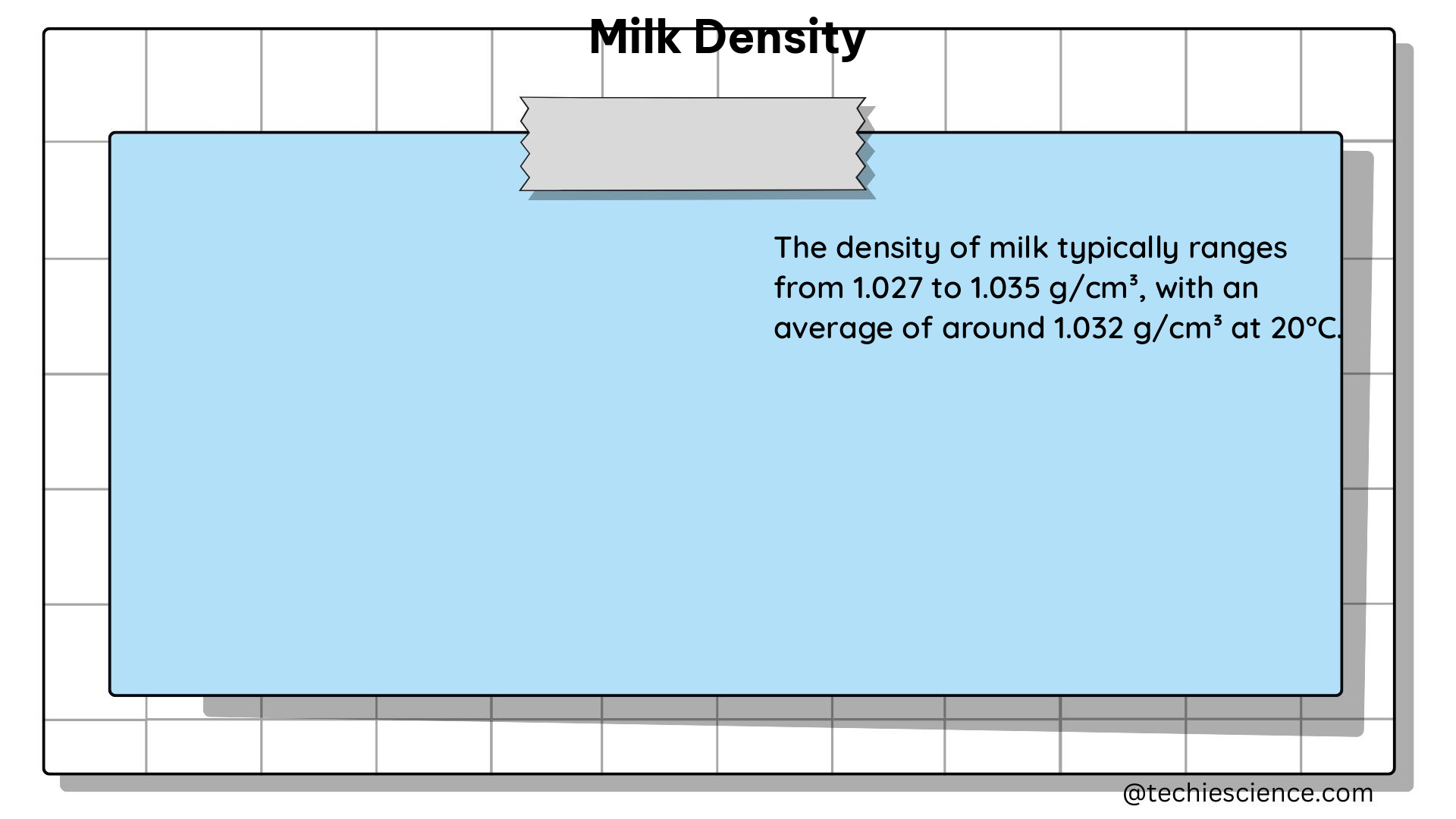Summary
Milk density is a crucial parameter in the dairy industry, as it affects the physical attributes and weight-volume calculations of milk products. This comprehensive guide delves into the intricacies of milk density, exploring the factors that influence it, the methods used to measure it, and the practical applications of this important property.
Understanding Milk Density

Milk density is a measure of the mass of milk per unit volume, typically expressed in grams per cubic centimeter (g/cm³) or kilograms per cubic meter (kg/m³). This property is influenced by various factors, including the composition of milk, seasonal variations, and temperature.
Factors Affecting Milk Density
-
Milk Composition: The density of milk is primarily determined by its composition, which includes the concentrations of fat, protein, lactose, and other solids. Changes in these components can significantly impact the overall density of the milk.
-
Seasonal Variations: Milk composition can vary throughout the year due to factors such as feed, climate, and stage of lactation. These seasonal changes can lead to fluctuations in milk density.
-
Temperature: The density of milk is also affected by temperature. As the temperature of milk increases, its density decreases due to the expansion of the liquid.
Measuring Milk Density
Milk density can be measured using various methods, including:
- Portable Density Meter (DMA 35): A compact and portable device that measures the density of milk samples.
- Desktop Density Meter (DMA 4500M): A more sophisticated and accurate desktop version of the density meter.
- AOAC Method using Pycnometers: A standard method that involves the use of 100-mL glass pycnometers to determine the density of milk samples.
Statistical analysis, such as linear mixed models, can be used to evaluate the significance of differences in milk density across seasonal and compositional variations.
Milk Density Calculations and Applications
Density Formula
The density of a substance, including milk, is given by the formula:
Density (ρ) = Mass (m) / Volume (V)
Where mass is the amount of substance, and volume is the space it occupies.
Physics Examples
-
Example 1: Consider a sample of milk with a mass of 1 kg and a volume of 1 liter (0.001 m³). The density of the milk can be calculated as:
Milk Density (ρ) = Mass of Milk (m) / Volume of Milk (V)
ρ = 1 kg / 0.001 m³
ρ = 1000 kg/m³ -
Example 2: A sample of milk has a mass of 500 g and a volume of 500 mL (0.0005 m³). Calculate the density of the milk.
Milk Density (ρ) = Mass of Milk (m) / Volume of Milk (V)
ρ = 0.5 kg / 0.0005 m³
ρ = 1000 kg/m³
Practical Applications of Milk Density
-
Milk Processing: Milk density is an important factor in milk processing, as it is used to estimate the individual milk constituents (fat, protein, lactose) through weight-volume calculations. This information is crucial for product portfolio management, operating capacities, and market demand.
-
Milk Payment Systems: The estimation of new density factors, based on seasonal and compositional variations, can enable improvements in milk payment systems for both the production and processing industries.
-
Product Formulation: Milk density data, especially the variations across different milk types and temperatures, can be used to optimize product formulations and ensure consistent quality.
Milk Density Data and Measurements
The following table provides detailed information on the density of various milk products at different temperatures:
| Product Composition | Density (kg/L) at: |
|---|---|
| Product | Fat (%) |
| Producer milk (whole milk) | 4.00 |
| Homogenized milk | 3.6 |
| Skim milk, pkg | 0.02 |
| Fortified skim | 0.02 |
| Half and half | 12.25 |
| Half and half, fort. | 11.30 |
| Light cream | 20.00 |
*SNF stands for Solids-Not-Fat.
Conclusion
Milk density is a crucial property that varies with seasonal and compositional changes in milk. Understanding and accurately measuring milk density is essential for the dairy industry, as it directly impacts product formulation, processing, and payment systems. This comprehensive guide has provided a detailed overview of the factors affecting milk density, the methods used to measure it, and the practical applications of this important property. By leveraging this knowledge, dairy professionals can optimize their operations and ensure the quality and consistency of their milk products.
References
- Determination of MIlk Density (Specific Gravity) of a Milk sample_A. (2020, October 11). Retrieved from https://www.youtube.com/watch?v=agdFb9qPYQs
- Density Lab Pre-Lab: 1. Look up the… – Course Hero. (n.d.). Retrieved from https://www.coursehero.com/file/79010885/Density-Labdocx/
- The Effect of Compositional Changes Due to Seasonal Variation on… (2020, July 27). Retrieved from https://www.ncbi.nlm.nih.gov/pmc/articles/PMC7466286/

The lambdageeks.com Core SME Team is a group of experienced subject matter experts from diverse scientific and technical fields including Physics, Chemistry, Technology,Electronics & Electrical Engineering, Automotive, Mechanical Engineering. Our team collaborates to create high-quality, well-researched articles on a wide range of science and technology topics for the lambdageeks.com website.
All Our Senior SME are having more than 7 Years of experience in the respective fields . They are either Working Industry Professionals or assocaited With different Universities. Refer Our Authors Page to get to know About our Core SMEs.